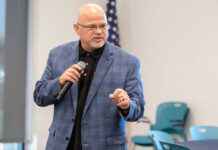
The position of superintendent emerged a decade or so after the creation of public schools. Initially there were no superintendents of schools. First, state boards ran schools, and then local lay boards, both without the benefit of professional help.
The actual creation of local boards of education dates back to Thomas Jefferson, who in 1779 introduced a proposal in the Virginia Assembly that the citizens of each county would elect three aldermen who would have general charge of the schools. The aldermen were to create an overseer for every ten school districts in the county. The duties included appointing and supervising teachers and examining pupils.
The local superintendency developed simultaneously with the state and county superintendent positions. It was established by local initiative, not by constitution or statute, as were the state and county superintendent post. Historically the relationship between the superintendent and the board has been team oriented even though the superintendent was and remains a paid position subject to the board direction.
However, this relationship has been challenged by decades of unrest, recent political action and the viewpoint that one person, the superintendent, is responsible for improvements in the district rather than the community as a whole. In other words, education has become something that the superintendent or an educator does to a child rather than something the community does for their children.
I clearly understand that I am the captain of the ship subject to the orders of the board however, I cannot steer the ship, chart the stars, rig the sails, weigh the anchor, fire the cannons, and feed the crew. The staff cannot do everything that is required to sail the ship either. Data from Dr. Berliner clearly shows that schools can only affect 20 percent of the factors that affect student achievement. The rest of the factors are either unknown (20 percent) or based on community culture (60 percent).
With the advent of superintendent performance pay this misconception grows. The reality is there is no Superman in education; good education has always been a partnership between the parents, school staff, members of the board, and patrons of the community. With that in mind and the fact budgets are tight I felt it important to outline a vision and a plan that moves us to think in terms of community, that defines the most important issues for moving forward during difficult times, and sets a foundation for budget decisions. I have named this plan, “Catching Excellence” based on the following quote by Vince Lombardi: “Perfection is unattainable, but if we chase perfection we can catch excellence.”
Schools and cities are buildings that house people and paper. As I see it we have two choices. We determine to build a city and schools or we decide to build a community. Building a community, though it requires physical and political structures, is more about people and their economic well being, health, neighbors, churches, social, moral, and educational needs. Think about this, America has the greatest disparity between the rich and the poor. We have the greatest wealth, the best universities, impressive estates, and the best hospitals, yet we have the highest infant mortality rate amongst the developed nations.
The countries the Federal government has pitted us against whose standardized test scores are used as a tool to cast blame on public education have the least economic disparity and the lowest infant mortality rate. There are no effective and widespread national or state programs for families with children ages 7 months to 3 years of age to help them teach their children to read. Yet, children from low socio-economic status families, families with low levels of education, new to the country, or socially deprived families can enter school as much as two years behind in their reading abilities.
This data may suggest that we as a nation don’t care about our children as much as we care about blaming someone for the problems.
Consider our local history. Prior to the boom the town of Maricopa was a tight-knit community. When the housing boom began there was no actual city of Maricopa. Developers advertised across the country with one thought in mind, sell homes. In my opinion most developers sought to build houses rather than homes which lay a foundation for a community. The developers of Province and Eldorado appear to be an exception.
People in the Town of Maricopa and the Pinal County saw growth coming but lacked the resources to prepare for the myriad of needs that arose with the influx of people. The school system was initially overwhelmed by the sudden growth and increased diversity. Some new home sales representatives encouraged potential customers to take their children to Tempe for their educational needs which also added to the diminishing sense of community. The tight-knit feeling that existed prior to the boom was either lost or contained within the boundaries of a small group of families.
If we choose to build edifices we will only provide people with parks to play in, classrooms and traffic lights. If we choose to build a community we will develop programs that reach out to those in need, provide careers rather than jobs, and we will develop our economy by taking care of our people.
I ask these questions, “What is the difference between someone who wants to be a part of a city and one who wants to be a part of a community?” and “What is the difference between a business that wants to come to a city and one that wants to be a part of a community?”
I am not sure what the answer is but we each need to choose community.
As a part of this plan I will ask members of the Maricopa Unified School District, City of Maricopa, Central Arizona Community College, service groups, economic development committees, parents, businesses, and many others to embrace and consider ways to build the community and invest in the social capital of Maricopa and thereby create the progeny we call the City of Maricopa.
Invest in social capital and the city will prosper morally, socially and economically. Build the community and students will have pride and prosper in our schools. Build community and invest in social capital and we will “Catch Excellence.”
Jeff Kleck is superintendent of the Maricopa Unified School District.
InMaricopa.com encourages readers to submit their thoughts and opinions on issues and events affecting Maricopa, Pinal County and Arizona. Please send 400 words or less to [email protected]. Include your full name, phone number and e-mail address along with any attribution you want included. If you have a good headshot of yourself, please send that too, attached as a JPG file. Letters and opinion pieces may be edited for length.









![City gave new manager big low-interest home loan City Manager Ben Bitter speaks during a Chamber of Commerce event at Global Water Resources on April 11, 2024. Bitter discussed the current state of economic development in Maricopa, as well as hinting at lowering property tax rates again. [Monica D. Spencer]](https://www.inmaricopa.com/wp-content/uploads/2024/04/spencer-041124-ben-bitter-chamber-property-taxes-web-218x150.jpg)


![In mayoral race, it’s the Nancy Smith show Maricopa Chamber of Commerce Executive Director Kelly Anderson grills incumbent Mayor Nancy Smith in election's first campaign event April 30, 2024, at Southern Dunes Golf Club. [Elias Weiss]](https://www.inmaricopa.com/wp-content/uploads/2024/04/CRM_1009-100x70.jpg)
![Merging lanes incite more 347 anger A merging lane sign sits on the side of State Route 347 northbound lanes during evening traffic on April 30, 2024. [Monica D. Spencer]](https://www.inmaricopa.com/wp-content/uploads/2024/04/spencer-043024-adot-merging-lanes-347-web-100x70.jpg)

